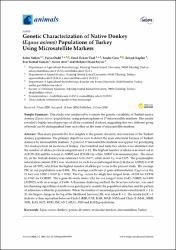Genetic characterization of native donkey (Equus asinus) populations of Turkey using microsatellite markers

Göster/
Erişim
info:eu-repo/semantics/openAccessTarih
2020Yazar
Yatkın, SelenÖzdil, Fulya
Ünal, Emel Özkan
Genç, Serdar
Kaplan, Selçuk
Gürcan, Eser Kemal
Arat, Sezen
Soysal, İhsan M.
Üst veri
Tüm öğe kaydını gösterKünye
Yatkın, S., Özdil, F., Özkan Ünal, E., Genç, S., Kaplan, S., Gürcan, E. K., ... & Soysal, M. I. (2020). Genetic Characterization of native donkey (Equus asinus) populations of Turkey using microsatellite markers. Animals, 10(6), 1093.Özet
This study presents the first insights to the genetic diversity and structure of the Turkish donkey populations. The primary objectives were to detect the main structural features of Turkish donkeys by microsatellite markers. A panel of 17 microsatellite markers was applied for genotyping 314 donkeys from 16 locations of Turkey. One hundred and forty‐two alleles were identified and the number of alleles per locus ranged from 4 to 12. The highest number of alleles was observed in AHT05 (12) and the lowest in ASB02 and HTG06 (4), while ASB17 was monomorphic. The mean HO in the Turkish donkey was estimated to be 0.677, while mean HE was 0.675. The polymorphic information content (PIC) was calculated for each locus and ranged from 0.36 (locus ASB02) to 0.98 (locus AHT05), which has the highest number of alleles per locus in the present study. The average PIC in our populations was 0.696. The average coefficient of gene differentiation (GST) over the 17 loci was 0.020 ± 0.037 (p < 0.01). The GST values for single loci ranged from −0.004 for LEX54 to 0.162 for COR082. Nei’s gene diversity index (Ht) for loci ranged from 0.445 (ASB02) to 0.890 (AHT05), with an average of 0.696. A Bayesian clustering method, the Structure software, was used for clustering algorithms of multi‐locus genotypes to identify the population structure and the pattern of admixture within the populations. When the number of ancestral populations varied from K = 1 to 20, the largest change in the log of the likelihood function (ΔK) was when K = 2. The results for K = 2 indicate a clear separation between Clade I (KIR, CAT, KAR, MAR, SAN) and Clade II (MAL, MER, TOK, KAS, KUT, KON, ISP, ANT, MUG, AYD and KAH) populations. © 2020 by the authors. Licensee MDPI, Basel, Switzerland.

















